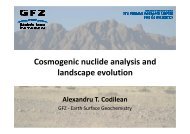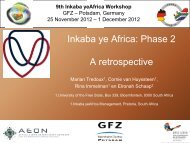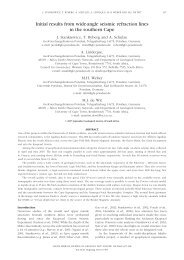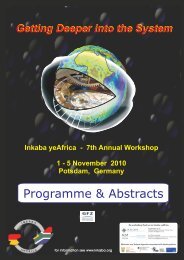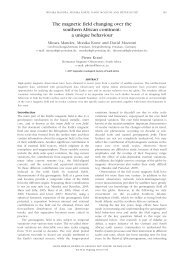South Africa - Inkaba.org
South Africa - Inkaba.org
South Africa - Inkaba.org
Create successful ePaper yourself
Turn your PDF publications into a flip-book with our unique Google optimized e-Paper software.
Can base metal sulphides be used as a proxy for platinumgroup<br />
mineral flotation of UG2 ore?<br />
Lekgetho T.B. 1,2 , Chetty D. 2 , Tredoux M. 1<br />
1. Geology department, University of the Free State, P.O. Box 339, Bloemfontein, 9300, <strong>South</strong> <strong>Africa</strong>,<br />
thelmal@mintek.co.za<br />
2. Mineralogy division, Mintek, Private Bag x3015, Randburg, 2125, <strong>South</strong> <strong>Africa</strong>.<br />
ABSTRACT<br />
Exhaustion of shallow Merensky Reef (MR) resources led to increased attention towards the Upper Group 2<br />
chromitite (UG2), following the metallurgical advances in its processing by the 1970s. Both MR and UG2 are<br />
recovered by sulphide flotation regardless of their different compositions. In this research project, mineralogy was<br />
used to optimise the platinum group minerals (PGM) beneficiation of UG2 ore by investigating whether flotation<br />
of the base metal sulphides (BMS) can be used as a proxy to predict the flotation behaviour of the PGM as done<br />
conventionally in the industry. The mineralogy and chemical composition of the primary feed, various concentrator<br />
cells and primary tailings of a UG2 concentrator plant were analysed using a mineral liberation analyser (MLA),<br />
X-ray diffraction (XRD), wavelength dispersive-X ray fluorescence (WD-XRF), inductively coupled plasmaoptical<br />
emission spectroscopy (ICP-OES) and LECO combustion.<br />
The PGM (~80% PGE-sulphides), BMS and silicates showed positive response to sulphide flotation. However, the<br />
BMS and PGM indicated negative correlation in grain size distribution as well as significant difference in grain<br />
size range (BMS range from 1µm to >45µm, while the PGM range between 1µm and 15µm). Mineral association<br />
and liberation thus played a major role in the flotation of the PGM, as most of the PGM lost to the tailings in the<br />
samples studied were not fully liberated and were associated with the BMS that are attached to the gangue.<br />
The study has shown that BMS flotation cannot be used as a proxy to predict the PGM flotation, as the PGM<br />
appear not to be wholly dependent on the BMS flotation. Liberating the PGM by finer grinding and floating the<br />
material in particle size classes may optimise recovery of the PGM.<br />
KEYWORDS: Platinum-group minerals (PGM), base metal sulphides (BMS), UG2 flotation, mineral liberation<br />
analyser (MLA).<br />
41



